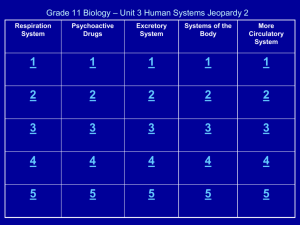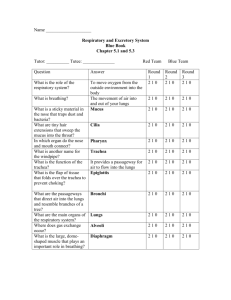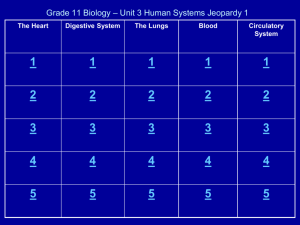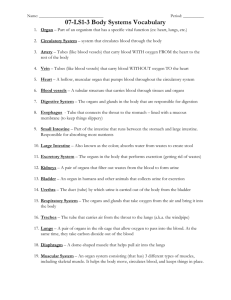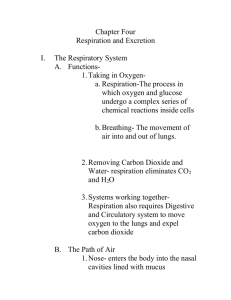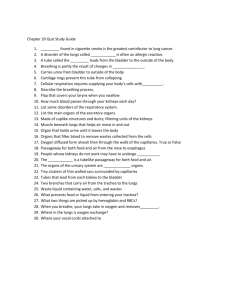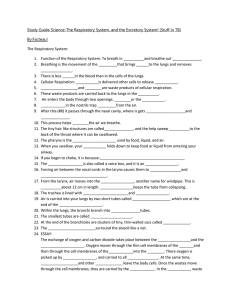Chapter 19: Respiration & Excretion
advertisement
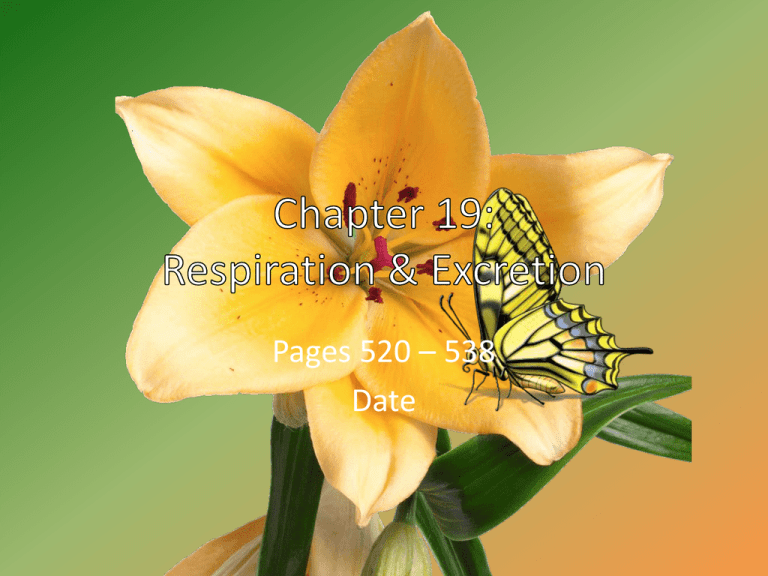
Pages 520 – 538 Date Functions of the Respiratory System (pg. 520 – 521) 1. Breathing = process whereby fresh air moves into & stale air moves out of lungs vs. 1. Respiration = oxygen is used in a series of chemical reactions to release energy in glucose Organs of the Respiratory System (pg. 522 – 523) 1. Air enters through nostrils or through mouth 1. Nose hair filters dust particles & the nasal cavity warms & moistens air w/ the help from mucus 2. Warm moist air moves into pharynx = tube like passageway for both food & air 1. Epiglottis @ the end of pharynx flaps over 2 prevent food or liquid 2 go into your larynx 3. Air then goes into larynx = where vocal cords R attached 4. Next is the trachea = tube lined w/ cartilage 2 keep it from collapsing 1. It’s lined w/ mucus & cilia to trap dust, bacteria, & pollen Bronchi & Lungs (pg. 524) 1. After trachea in the bronchi = two short branches that carry air into the lungs 2. Within the lungs, bronchi then branch off into bronchioles = smaller tubes 3. At the end of each bronchiole are clusters of thinwalled sacs = alveoli 1. They look like grapes & R surrounded w/ capillaries 4. Lungs = an organ made up of masses of alveoli Inhale & Exhale (pg. 525) 1. Diaphragm = muscle beneath your lungs that helps move air in & out of your body 1. It contract & relaxes as U breathe 2. Inhale diaphragm contracts & moves down expanding rib cage (greater volume, lower air pressure) 2 allow air in 3. Exhale diaphragm relaxes & moves up lowering rib cage (less volume, high air pressure) 2 allow air out Diseases & Disorders (pg. 527 – 529) 1. Many serious diseases R related 2 smoking, polluted air, & coal dust 2. Chronic bronchitis = bronchial tubes R irritated & too much mucus is produced 1. 2 much coughing can harm tubes & cilia scarring lung tissue …. can progress 2 emphysema 3. Emphysema = alveoli in lungs lose the ability 2 expand & contract 1. Less O2 in bloodstream, heart works harder, can lead 2 heart damage 4. Lung cancer = cancer (uncontrolled growth of cells) in lungs, which is triggered by inhaling carcinogens 5. Asthma = disorder of lungs, shortness of breath, wheezing, coughing 1. Bronchial tubes contract Excretory System (pg. 533) 1. Digestive, respiratory, urinary, and skin all work together 2 excrete wastes 2. Excretory organs = kidneys, lungs, & skin 3. Urinary system = organs that rid your blood of wastes produced by the metabolism of nutrients 1. Controls blood volume by eliminating excess water & balances certain salts Organs of Urinary System (pg. 534 – 535) 1. Kidneys = filter blood that has collected wastes from cells 2. Kidneys R each made up of about 1 million nephrons, which are tiny filtering units 3. Urine = contains excess water, salts, & other wastes not reabsorbed by the body 4. Urine then flows to the ureters = tubes that lead from kidney 2 bladder = elastic, muscular organs that stores urine until it leaves through urethra How to all works… 1. Blood enters kidneys through aorta (artery) 2. Then, blood enters the nephrons 3. Wastes in the blood R removed & stored in little cuplike structures 4. Then, capillaries reabsorb needed water, sugars & salts 5. The renal vein returns purified blood 2 B circulated 6. Urine drains from collecting tubule into funnel shaped tube 7. Urine travels from ureters 2 bladder 8. Urine flows from bladder through urethra out of body Water Losses (pg. 535) 1. U lose water through your skin each day by sweating 2. U also lose water when breathing (water vapor) 3. Small amounts of water are lost through the digestive system too Diseases and Disorders (pg. 537 – 538) 1. When urinary system does work waste products build up & act as poisons in the body 1. Water can accumulates & causes swelling 2. Imbalance of salts prevents normal cell functioning 3. Kidney failure can lead 2 death 2. A person who has damaged kidneys will need dialysis = blood is filtered through an artificial kidney machine
